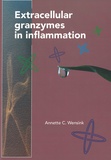Extracellular granzymes in inflammation

Wensink, Annette
- Promoter:
- Prof.dr. C.E. (Erik) Hack & prof.dr. P.J. (Paul) van Diest
- Co-promoter:
- Dr. A.N. (Niels) Bovenschen
- Research group:
- Bovenschen
- Date:
- September 23, 2014
- Time:
- 12:45 h
Summary
It has been well established that granzymes released by cytotoxic lymphocytes induce cell death in virus-infected cells and tumor cells. Next to this intracellular role of granzymes in triggering apoptosis, granzymes also exist extracellularly in the circulation of patients with autoimmune diseases and infections, including bacterial infections. However, the function of these extracellular granzymes in inflammation largely remains unknown. In this thesis, we establish novel immunomodulatory functions of granzymes K and A. We demonstrate that granzyme K (GrK) binds to Gram-negative bacteria and lipopolysaccharide (LPS), and synergistically enhances cytokine responses from human monocytes induced by LPS or Gram-negative bacteria. GrK furthermore enhances the LPS-induced cytokine release in vivo in mice (Chapter 2). These extracellular effects are independent of GrK catalytic activity. GrK augments complex formation between LPS and CD14 and disaggregates LPS from micelles. We conclude that extracellular GrK is a direct and physiological modulator of LPS-TLR4 signaling during the anti-microbial innate immune response. In addition, we demonstrate that human granzyme A (GrA) also potentiates cytokine responses in human monocytes initiated by LPS or Gram-negative bacteria (chapter 3). Like for GrK, this effect is independent of GrA catalytic activity, and GrA binds to certain Gram-negative bacterial strains. Unlike GrK, however, GrA does not bind to LPS, and has little influence on LPS micelle disaggregation. Therefore, GrA and GrK differentially modulate LPS-Toll-like receptor 4 signaling in monocytes, suggesting functional redundancy amongst granzymes in the anti-bacterial innate immune response. In chapter 4, we investigate whether granzymes are released into the circulation upon LPS challenge. We find that GrK and notably GrM are transiently elevated in human volunteers injected with LPS. Furthermore, we demonstrate that GrM is released when whole blood cultures are stimulated with LPS or Gram-negative bacteria. GrK was released only in response to Pseudomonas aeruginosa, suggesting differential release of granzymes in response to different bacterial strains. In chapter 5, we investigate GrM and GrK release in Rheumatoid Arthritis (RA) patients. In contrast to GrA and GrB, GrM and GrK are not elevated in RA serum. We demonstrate that GrM, but not GrK, is elevated in synovial fluid from RA patients, and that GrM levels correlate with levels of several pro-inflammatory cytokines. These data imply that GrM contributes to disease progression in RA. In chapter 6 we compare the macromolecular substrate specificities of mouse and human GrK (mGrK and hGrK). About 40% of cleaved substrates overlap between mGrK and hGrK, indicating that caution is required when extrapolating data obtained in mice to the human situation. Furthermore, we show that both mGrK and hGrK are not cytotoxic towards human or murine tumor cell lines. Chapter 7 deals with the role of granzymes in controlling the reactivation of the human cytomegalovirus (HCMV) after allogeneic stem cell transplantation. Increased percentages of GrM- and GrB-expressing lymphocytes are found in patients with HCMV reactivation, compared to patients without reactivation. Also, GrM serum levels are elevated in patients with HCMV reactivation. This suggests that both GrM and GrB contribute to the control of the virus after reactivation.